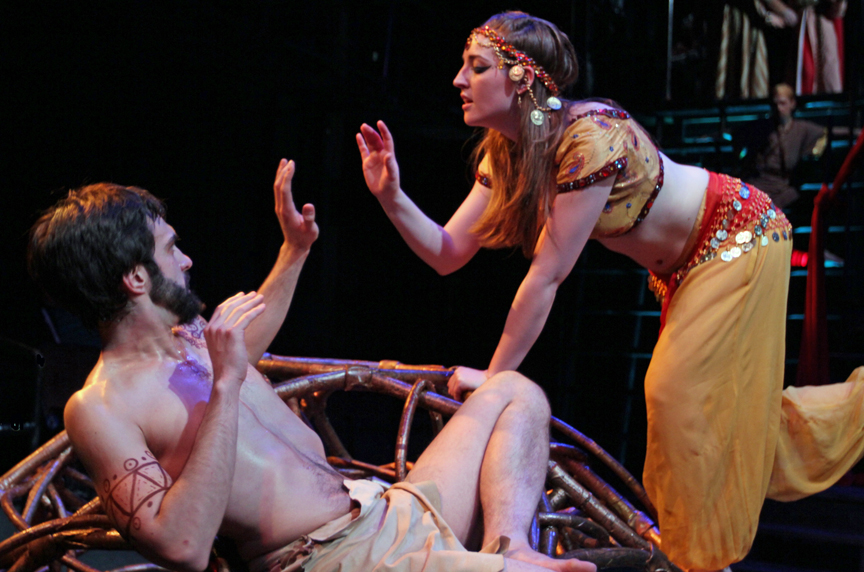
Salome. By Oscar Wilde. Premier of a new translation by Joseph Donohue at Villanova Theatre, 2014
Salome: A Tragedy in One Act. Translated by Joseph Donohue. University of Virginia Press.
Oscar Wilde’s play Salome has not gotten much respect. Its only Broadway production, in 2003 with Al Pacino, was roundly denounced.
Clive Barnes in the New York Post said “The play is extraordinarily bad. Why stage Salome at all?” Ben Brantley in the Times wrote, “How can you deliver dramatic moments like Salome’s kissing the decapitated head of John the Baptist without inviting hoots?”
Those disparagements can now be dismissed. A production by Villanova University reveals Wilde’s play to be mesmerizing theater. Credit belongs equally to a new translation by Joseph Donohue, to imaginative staging by Father David Cregan and some captivating acting.
Wilde wrote Salome in French in 1891 in a style radically different from his witty drawing-room comedies like The Importance of Being Earnest and Lady Windermere’s Fan.
He was spending more time in Paris than in London; Parisians accepted him while the Victorian society back home shunned him — and later arrested and jailed him for “gross indecency.” There he embraced French (and Belgian) symbolist writers such as Stéphane Mallarmé and Maurice Maeterlinck, whose work was marked by the musical qualities of language, dreamlike romanticism and metaphorical allusions. Wilde said “There was another instrument to which I had listened all my life, and I wanted once to touch this new instrument to see whether I could make any beautiful thing out of it.”
Wilde’s description of French language as an instrument was apt, for he constructed Salome as a piece of music. He used repetitious rhythms and wrote recurring phrases that returned like Wagner’s leitmotivs. No wonder that Salome achieved success when it later was turned into an opera by Richard Strauss.
One year after its premiere in Paris, an English translation was published by Wilde’s lover, Lord Alfred Douglas. It used archaic language similar to the King James bible, which protectively distanced and shielded the audience from the drama. Donohue, a theater historian specializing in Irish and English drama, wrote this translation using modern words that connect directly.
Donohue’s work hews more closely to Wilde’s French, which has fewer root words than does English, which led Wilde to reiterate key words four or five times to good effect.
The spirit of Salome is epitomized in colorful similes. A young Syrian page is enraptured by Salome. He says she has feet like white doves, and she is like the shadow of a white rose in a mirror of silver. Numerous characters describe the moon: “She is like a dead woman rising from a tomb”; “like a woman looking for lovers”; “like a silver flower”; “a virgin.” Sardonically, providing comic relief, Herod’s wife says “The moon is the moon. That’s all.”
Director Cregan took this fantastical heightened speech and presented it in a stylized manner, accompanied by expressive body language and by percussive musical instruments. Sometimes we heard hand-held drums, at other times the pounding of spears against the ground. We also heard biblical chanting in Hebrew and Aramaic.
An unspoken metaphor of the play is the desire of this biblical-era woman to rise above her subservient position. She does that by using sex appeal to get her way. And in this production she grabs hold of red silks that seemingly hang from the sky and she climbs up them. Salome’s Dance of the Seven Veils here was aerialist artistry (no veils).
Lizzy Pecora was spectacular as a Salome headstrong and narcissistic. Although she is a graduate student in her twenties, Pecora looks like a petite adolescent. Her voice is surprisingly strong as she projects the character’s power. Pecora, by the way, had no training in climbing, gymnastics or dancing before she was cast in this role.
The character is fascinated by Iokanaan (spelled Jokanaan in some other versions), the prophet John the Baptist. She speaks of his beautiful alabaster-white body. When he repels Salome she says that now she hates his body but loves his long black hair. When he again rejects her she says she hates his ugly hair but loves his red mouth.
King Herod lusts for his step-daughter and wants her to dance for him. He promises her anything and, at the conclusion of the dance, she asks for the head of John on a silver platter. Some of the most flamboyant imagery of the play is Herod’s description of the various treasures he’ll give Salome if only she’ll drop her request for the prophet’s head.
Seth Thomas Schmitt-Hall was a vivid Herod, speaking in the flowery manner of a ruler who always got his way and moving like a strutting peacock. Peter Andrew Danzig was an impressive Iokanaan and Jen Jaynes was a tantalizing Herodias, the mother of Salome. Her husband had been Herod’s brother. She cheated on her husband, Herod had him strangled and Herod took the throne and married her. (Shades of Hamlet.)
The play ends sadly and hauntingly when Salome kisses the prophet’s dead lips. “Iokanaan, why wouldn’t you look at me? If you had looked at me (psychologists would say If you ever had really seen me) you would have loved me. The mystery of love is greater than the mystery of death.”
The earlier critics were wrong. This is great theater. Of course, they never saw this production.
Read other reviews on The Cultural Critic